|
The
"Mackinaw-Aldrich Cache"
Hopewell Snyders and North Points
"THE BEST EXAMPLES OF CHIPPED FLINT WORK EVER FOUND IN AMERICA!"
(A comment made by Dr. W. H. Holmes---Smithsonian
Institution)
"FLINTS LIKE STRINGS OF PEARLS!"
(Story title in the Pantagraph---Bloomington, Ill.
newspaper Jan. 6, 1949)
|
|
THE
EXTRAORDINARY!
"MACKINAW-
ALDRICH CACHE"
MIDDLE
WOODLAND
HOPEWELL CULTURE
TAZEWELL COUNTY,
ILLINOIS
OWNED BY THE
PEOPLE OF ILLINOIS
ON DISPLAY IN
THE ILLINOIS STATE MUSEUM SPRINGFIELD, Illinois
Throughout the history of human development there
have been a few artisans and craftsman who have taken their particular
occupation to a level of quality that far surpasses most of their colleges.
Whether it's a painting on a cave wall, a modern day architectural wonder or
even a flaked stone tool the best work always stands out for everyone to marvel
at. Well over two thousand years ago, in what is now Tazewell County,
Illinois, such an artisan worked on a cache of Hopewell points. It's
generally believed by all who have studied these points that whoever made them
had developed his flintknapping skill to the highest level attainable for his
time within his culture. Dr. W. H. Holmes was the head curator of Anthropology
at the Smithsonian Institution when these points were found in 1916. He remarked
that they were "the best examples of chipped flint work ever found in
America." They survive as a tribute to this ancient craftsman's skill.
What is a cache? The definition of a cache is a place where
something is stored or hidden. When used in reference to Stone Age artifacts it
defines two or more artifacts found together that were originally placed
together. A cache could either be ceremonial or utilitarian. Many caches of
artifacts such as ceramic pots or chipped stone artifacts have been found with
burials as offerings to the dead. They are also found on ancient quarry sites
where unfinished preforms were left for eventual transport
to a camp or village site but for some reason were never recovered for their intended
use. Caches are also frequently found during excavation of ancient house floors.
In North America some of the largest caches have been found in Middle Woodland
Hopewell burial mounds. More than 8,000 "disks" or preforms were
excavated from a mound in Ross County, Ohio.
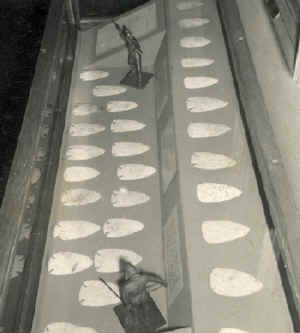
DISPLAY OF THE MACKINAW CACHE AS IT
APPEARED IN 1957.
ILLINOIS STATE MUSEUM
|
|
THE
MACKINAW /ALDRICH CACHE
TAZEWELL COUNTY, ILLINOIS
OWNED BY THE PEOPLE OF
ILLINOIS
The Mackinaw- Aldrich Cache was discovered in 1916 by some boys hauling gravel from
the side of a small hill at the edge of a bluff line on a farm owned by
James Tyrrell. The site is located a quarter of a mile from the Mackinaw
River and about two and a half miles northeast of the town of Mackinaw in
Tazewell County, Illinois. The boys estimated that about 40
points were found in this cache but the broken ones were not collected.
Only a total of 33 points were ever accounted for. Thirty one are now
located in the Illinois State Museum where the majority of them are on display.
People refer to this group of artifacts as the Mackinaw Cache
after the area where they were found. But they were named in early writings as the Aldrich
Cache because Frank W. Aldrich was the man
responsible for the recovery of the 31 points now in the Illinois State
Museum. As soon as he heard about the find in 1916 he set a goal to recover as
many of the points the cache as possible from the several different people
who owned them. Some of this process is recorded in a letter dated Dec.
1916 that is addressed to Mr. Aldrich and written by James Tyrell, the
owner of the land on which the cache was found. In this letter Mr. Tyrell
is offering to sell seven of the eight points he has for $7.00 apiece. Mr.
Aldrich responds with another letter written on Dec. 14, 1916 with an
offer of $5.00 apiece for all eight points. It was not until 1948 that he was
satisfied that all the cache that would ever be available to him was
collected. It was probably around this time that he made casts of the
points. In fact when Dr. W. H. Holmes from the The Smithsonian
Institution's Anthropology Department saw the casts he requested
permission to also make casts which were then displayed for several years
in the National Museum. It was at this time that Mr. Aldrich presented the collection tothe Illinois
State Museum where most of the cache has been and currently is beautifully
displayed.
Although they were never scientifically excavated and proven
to belong to a specific culture this cache is believed to be and most
probably was made by someone living during the Middle Woodland Hopewell
period approximately 2,500 years ago. These points appear to be stylized
versions of Snyders and North points. A North point is simply an unnotched
Snyders point. The points in this cache are all "oversized"
versions of normal utilitarian examples found on Middle Woodland village
sites. They are also too fragile the Illinois
State Museum where most of the cache has been and currently is beautifully
displayed.
Although they were never scientifically excavated and proven
to belong to a specific culture this cache is believed to be and most
probably was made by someone living during the Middle Woodland Hopewell
period approximately 2,500 years ago. These points appear to be stylized
versions of Snyders and North points. A North point is simply an unnotched
Snyders point. The points in this cache are all "oversized"
versions of normal utilitarian examples found on Middle Woodland village
sites. They are also too fragile for use as knives.
An
article in the April 1949 issue of "The Journal of the Illinois State
Archaeological Society" states "they are too delicate to be of
practical use. They are pure examples of art for art's sake."
Of particular interest to people studying the manufacturing techniques
used to make these points are the notches. Rather than using direct
pressure it is fairly certain that these notches were made by indirect
pressure flaking. This technique was done in a similar way a hammer and chisel
is used. The pressure flaker was struck by a hammering tool to remove the
notching flakes rather than pressing them off by hand pressure only.
When Mr. Aldrich owned this cache he also had blue prints
made that show their outline with individual numbers and the dimensions of
each point. The length of the notched points range in size from 4 10/16 to
5 7/16 inches and the widths from 2 11/16 to 2 15/16 inches. The average
thickness at the base is 3/16 of an inch. The unnotched points average
slightly smaller. It has been suggested (by a brilliant flintknapper
friend) that the unnotched points were broken during the notching process
and were then trimmed across the base.
|
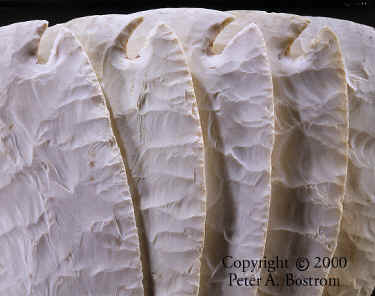
CLICK ON
PICTURE FOR LARGE IMAGE!
FIVE MACKINAW-ALDRICH CACHE POINTS
TAZEWELL COUNTY,
ILLINOIS
OWNED BY
THE PEOPLE OF ILLINOIS
Of particular interest are the notches. They were made with a fairly rare
notching technique called indirect pressure flaking rather than the
normally used direct pressure flaking technique.
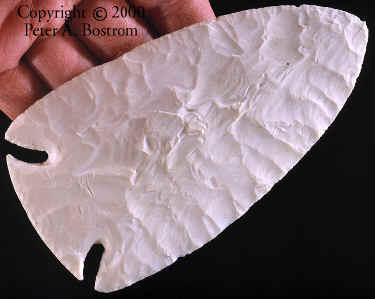
CLICK ON
PICTURE FOR LARGE IMAGE SHOWING THREE SIDES!
#10
SNYDERS POINT
TAZEWELL COUNTY,
ILLINOIS
OWNED
BY THE PEOPLE OF ILLINOIS
This is one of approximately 20 corner points found in the Mackinaw Cache. 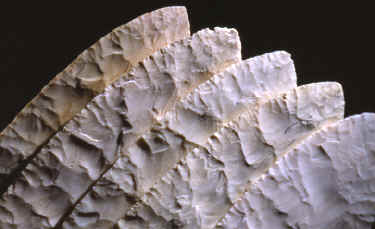
FIVE EXAMPLES
FROM THE MACKINAW- ALDRICH CACHE
TAZEWELL COUNTY, ILLINOIS
OWNED BY THE PEOPLE OF ILLINOIS
This picture shows the considerable amount of pressure flaking that was
applied along the edges during the manufacture of these points. The
understanding of flaking techniques have come a long way in just a few
years. For example, in the 1952 publication "Hopewellian Communities
in Illinois" on page 259 a reference is made to this cache.
"There is no pressure retouching of the edges." 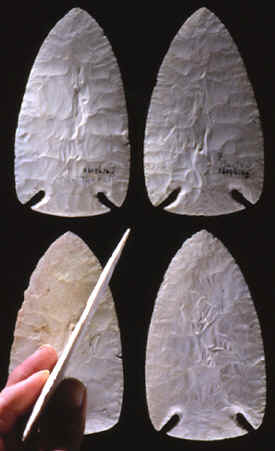
FIVE EXAMPLES FROM THE MACKINAW-
ALDRICH CACHE
TAZEWELL COUNTY, ILLINOIS
OWNED BY THE PEOPLE OF
ILLINOIS
The average thickness at the base of these points is 3/16 of an inch.
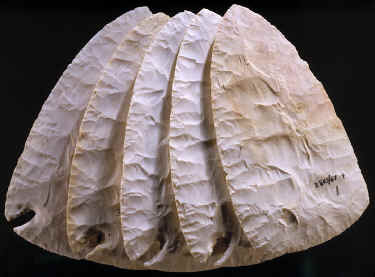
CLICK ON
PICTURE FOR LARGE IMAGE
FIVE EXAMPLES
FROM THE MACKINAW- ALDRICH CACHE
TAZEWELL
COUNTY, ILLINOIS
OWNED BY
THE PEOPLE OF ILLINOIS
This picture shows four notched and one of the unnotched points. In a
total of 33 known examples, 31 in the Illinois State Museum and 2 that
were originally in the McLean County Historical Society in Bloomington,
there are 20 notched and 13 unnotched points in this cache.
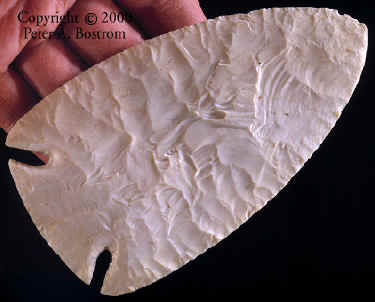
CLICK ON PICTURE
FOR LARGE IMAGE SHOWING THREE SIDES!
#9
SNYDERS POINT
MACKINAW-ALDRICH CACHE
OWNED BY THE
PEOPLE OF ILLINOIS
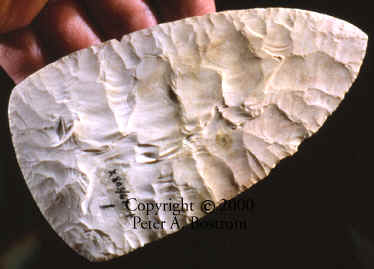
CLICK ON PICTURE
FOR LARGE IMAGE SHOWING THREE SIDES!
#1
UNNOTCHED NORTH POINT
MACKINAW-ALDRICH CACHE
OWNED BY THE PEOPLE OF
ILLINOIS
A
CAST OF NO.7 IS AVAILABLE
---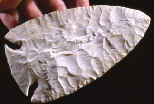
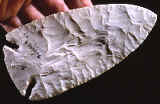 ---- ----
CLICK ON PICTURES FOR
IMAGES SHOWING THREE SIDES!
#7 and #4
TWO NOTCHED SNYDERS POINTS
MACKINAW-ALDRICH
CACHE
OWNED BY THE
PEOPLE OF ILLINOIS
|
|
"REFFERENCES"
1916,
From original letters by Mr. Aldrich and Mr. Tyrrell.
1949, Jan. 16, "The Pantagraph" newspaper, Bloomington,
Illinois.
1949, "Journal of the Illinois State Archaeological Society, April
Vol. 6, No.4 pp15-19.
1952, "Hopewell Communities in Illinois", p. 259
|

 ----
----






